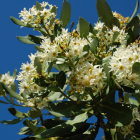One of the tasks of the European voyages around the globe from the sixteenth through the eighteenth century was to discover new environmental resources. In 1578, in the Strait of Magellan (Figure 1), the English traveler John Winter found a new plant, which was officially named in his honor: Drimys winteri. Nowadays, the ground bark of the species is actively sold as a “Mapuche pepper from the canelo tree.” This is a popular commercial product, which represents one of the recent gastronomic symbols of modern Chile.
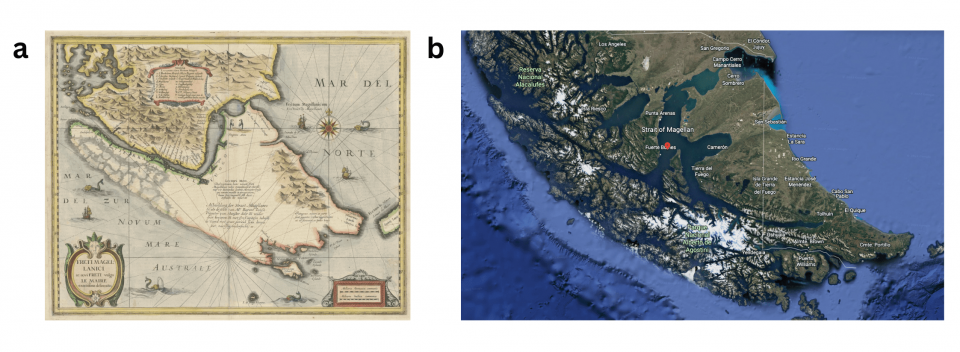
Fig.1. Geographical representations of the Strait of Magellan. a) Hondius, Jodocus, Freti Magellanici, (Amsterdam, 1635). Copperplate map, with added color, 37 × 48 cm. Reference: Mateo Martinic, Cartografía magallánica: 1523–1945, (Punta Arenas: University of Magallanes, 1999), VIII, 97; b) Study area.
Fig.1. Geographical representations of the Strait of Magellan. a) Hondius, Jodocus, Freti Magellanici, (Amsterdam, 1635). Copperplate map, with added color, 37 × 48 cm. Reference: Mateo Martinic, Cartografía magallánica: 1523–1945, (Punta Arenas: University of Magallanes, 1999), VIII, 97; b) Study area.
a) created by Jodocus Hondt. b) created with Google Earth.
 This work is licensed under a Creative Commons Public Domain Mark 1.0 License.
This work is licensed under a Creative Commons Public Domain Mark 1.0 License.
In Mapudungun, the language of the Mapuche people—one of the Indigenous communities settled in central and southern Chile and southern Argentina—the tree is called foye. The Mapuche have perceived it as sacred and have used it for funerary rituals and medicinal purposes (Figure 2). In the seventeenth century, the Chilean writer Francisco Núñez de Pineda y Bascuñán and the Spanish Jesuit Diego de Rosales, who spent many years in Chile as a missionary, reported ethnomedical Indigenous uses of the plant. Nevertheless, their manuscripts were not published until the end of the colonial era.
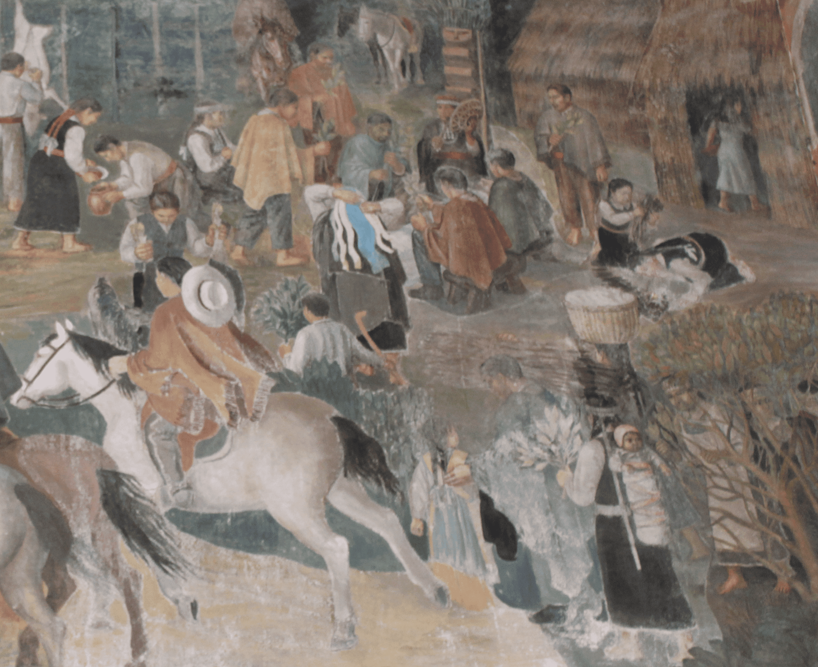
Fig.2. Healing ceremony with Drimys winteri. Fragment of mural “Historia de la medicina y la farmacia en Chile,” painted in 1957–58 in Concepción (Chile) by the Chilean artist Julio Escámez. Credit: Fernando Venegas E. (2016).
Fig.2. Healing ceremony with Drimys winteri. Fragment of mural “Historia de la medicina y la farmacia en Chile,” painted in 1957–58 in Concepción (Chile) by the Chilean artist Julio Escámez. Credit: Fernando Venegas E. (2016).
© 2016 Fernando Venegas E. Used by permission.
The copyright holder reserves, or holds for their own use, all the rights provided by copyright law, such as distribution, performance, and creation of derivative works.
During transoceanic voyages, sailors considered Drimys winteri a food spice, since it had a similar taste to pepper (Piper nigrum) or cinnamon (Cinnamomum verum). The tree’s bark was also used as a remedy against scurvy, a disease resulting from decreased vitamin C during long travels. At the same time, European scholars did not report any use of the plant among the Indigenous communities that settled the Straits. The exclusion of Indigenous and local knowledge was also supported in the Natural History of Chile (Histórica relación del Reyno de Chile), published by the Chilean Jesuit Alonso de Ovalle in 1646. According to sailors’ reports, Ovalle stated, there is a tree in the Strait of Magellan called canelo, similar to pepper and cinnamon. European descriptions of Drimys winteri were primarily based upon the records of navigators, who emphasized analogies with cinnamon in order to boost sales of the product. In 1582, the Dutch naturalist Carolus Clusius published the first botanical description of the plant. Afterwards, Clusius’s representation started to circulate in European written sources. Colonial botanists mainly stressed the similarity of Drimys winteri to cinnamon. French botanist and traveler Louis Feuillée, among others, classified the specimen within European plant taxonomy as Boigue cinnamomifera, consciously evoking the taste and color of cinnamon. Even in the eighteenth century, such as in the book published by the Scottish illustrator Elizabeth Blackwell and the German botanist Johann Wilhelm Weinmann, the misidentification of the tree with Cinnamomum verum was still being circulated (Figure 3).
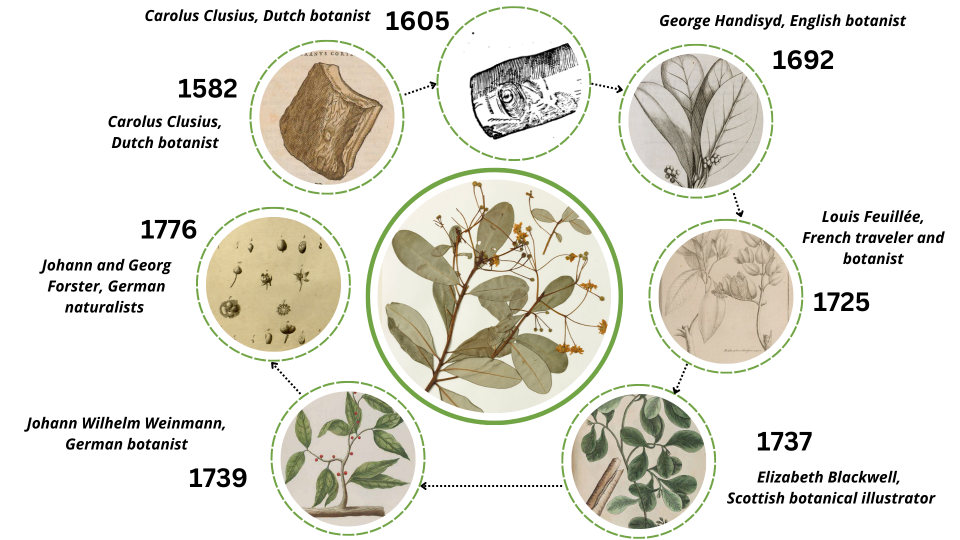
Fig.3. The engravings of Drimys winteri circulated in European written sources from 1582 to 1776. Carolus Clusius, Aliquot Notae in Garciae Aromatum Historiam, (Antwerp: Christopher Plantin, 1582), 31; Carolus Clusius, Exoticorum Libri Decem, (Leiden: Ex officina Plantiniana Raphelengii, 1605), 77; Hans Sloane, “An Account of the True Cortex Winteranus, and the Tree That Hears It,” Philosophical Transactions, (1693), 17: 204; Louis Feuillée, Journal Des Observations Physiques, Mathematiques et Botaniques, (Paris: Jean Mariette, 1725), 6; Elizabeth Blackwell, A Curious Herbal, (London: John Nurse, 1739), Vol. 1:, 206; Johann Wilhelm Weinmann, Phytanthoza iconographia, (Regensburg: Apud praenominatos Pict. & Chalcogr., 1739), 2: 302; Johan Forster and George Forster, Characteres generum plantarum, (London: Prostant apud B. White, T. Cadell, and P. Elmsly, 1776), 84. Central picture: herbarium specimen from The Royal Botanic Gardens collection, Kew (http://specimens.kew.org/herbarium/K001106424).
Fig.3. The engravings of Drimys winteri circulated in European written sources from 1582 to 1776. Carolus Clusius, Aliquot Notae in Garciae Aromatum Historiam, (Antwerp: Christopher Plantin, 1582), 31; Carolus Clusius, Exoticorum Libri Decem, (Leiden: Ex officina Plantiniana Raphelengii, 1605), 77; Hans Sloane, “An Account of the True Cortex Winteranus, and the Tree That Hears It,” Philosophical Transactions, (1693), 17: 204; Louis Feuillée, Journal Des Observations Physiques, Mathematiques et Botaniques, (Paris: Jean Mariette, 1725), 6; Elizabeth Blackwell, A Curious Herbal, (London: John Nurse, 1739), Vol. 1:, 206; Johann Wilhelm Weinmann, Phytanthoza iconographia, (Regensburg: Apud praenominatos Pict. & Chalcogr., 1739), 2: 302; Johan Forster and George Forster, Characteres generum plantarum, (London: Prostant apud B. White, T. Cadell, and P. Elmsly, 1776), 84. Central picture: herbarium specimen from The Royal Botanic Gardens collection, Kew (http://specimens.kew.org/herbarium/K001106424).
Courtesy of Carolus Clusius, George Handisyd, Louis Feuillée, Elizabeth Blackwell, Johann Wilhelm Weinmann, Johann, and Georg Forster.
 This work is licensed under a Creative Commons Public Domain Mark 1.0 License.
This work is licensed under a Creative Commons Public Domain Mark 1.0 License.
In the Natural History of Chile, Jesuits presented canelo to a European audience, stressing the analogy to the European knowledge system. In 1776, the German botanists George and Johann Reinhold Forster assigned it the scientific name Drimys winteri, reporting it as a medicinal plant used against scurvy and recommending it instead of Jesuit’s Bark (Cinchona officinalis).
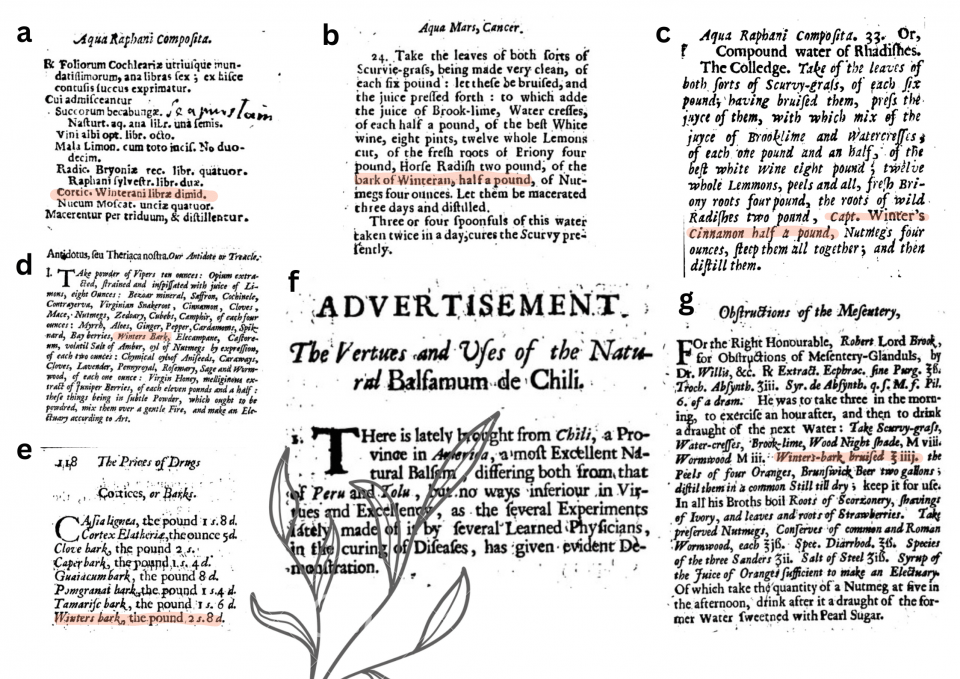
Fig.4. The advertisements of William Salmon for “Balsam de Chili.” a) Royal College of Physicians of London and Thomas Healde, Pharmacopoeia Londinensis Collegarum, (London: W. Bentley, L. Sadler, and R. Beaumont, 1651), 64; b) John Heydon, The Holy Guide: Leading the Way to Long Life, Health, Youth, (London: T. M., 1662), 5: 45; c) Nicholas Culpeper, Pharmacopoeia Londinensis or the London Dispensatory further Adorned by the Studies and Collections of the Fellows, (London: George Sawbridge, 1675), 94; d) William Salmon, Polygraphice, (London: Thomas Passenger, 1685), 7: 724; e) Gideon Harvey, The Family Physician and the House Apothecaries, (London: T. R., 1676), 118; f) William Salmon, Systema Medicinale, a Complete System of Physick Theoretical and Practical, (London: T. Passenger, 1686), Advertisement; g) John Hall, Select Observations on English Bodies of Eminent Persons in Desperate Diseases, (London: William Marshall, 1683), 286.
Fig.4. The advertisements of William Salmon for “Balsam de Chili.” a) Royal College of Physicians of London and Thomas Healde, Pharmacopoeia Londinensis Collegarum, (London: W. Bentley, L. Sadler, and R. Beaumont, 1651), 64; b) John Heydon, The Holy Guide: Leading the Way to Long Life, Health, Youth, (London: T. M., 1662), 5: 45; c) Nicholas Culpeper, Pharmacopoeia Londinensis or the London Dispensatory further Adorned by the Studies and Collections of the Fellows, (London: George Sawbridge, 1675), 94; d) William Salmon, Polygraphice, (London: Thomas Passenger, 1685), 7: 724; e) Gideon Harvey, The Family Physician and the House Apothecaries, (London: T. R., 1676), 118; f) William Salmon, Systema Medicinale, a Complete System of Physick Theoretical and Practical, (London: T. Passenger, 1686), Advertisement; g) John Hall, Select Observations on English Bodies of Eminent Persons in Desperate Diseases, (London: William Marshall, 1683), 286.
Courtesy of the Royal College of Physicians of London and Thomas Healde, John Heydon, Nicholas Culpeper, William Salmon, Gideon Harvey, John Hall.
 This work is licensed under a Creative Commons Public Domain Mark 1.0 License.
This work is licensed under a Creative Commons Public Domain Mark 1.0 License.
At the end of the seventeenth century, the British physician William Salmon and booksellers Thomas Passenger and Ebenezer Tracy began to sell a special product by the name of “Balsam de Chili.” The remedy was advertised as being similar to “Balsam de Peru,” a famous panacea in that period. The miraculous ingredient in this balsam, reported to be a “small tree of Chili,” was probably Drimys winteri. In the same period, the studied plant, known in England as Winter’s Bark or Winter’s cinnamon, was used by English apothecaries in many recipes (Figure 4). Nevertheless, the Chilean native plant was often confused with cinnamon and Canella alba (Canella winterana). After the British naturalist Hans Sloane, in 1693, published traveler George Handisyd’s botanical description of Drimys winteri, Balsam de Chili gradually disappeared from the English market.

Fig.5. Drimys winteri.
Fig.5. Drimys winteri.
© Diego Alarcón, Herbarium of Concepción, Chile. Used by permission. Click here to view the source.
The copyright holder reserves, or holds for their own use, all the rights provided by copyright law, such as distribution, performance, and creation of derivative works.
During the colonial period, Indigenous and local environmental knowledge about Drimys winteri was partly ignored by European voyagers. The constructed knowledge system circulated in the European written sources was mainly based on travelers’ reports and entirely limited to European botanical knowledge. Stated scientific nonknowledge and exclusion of Other ecological knowledge might represent a form of environmental ignorance: that is, not only a lack of knowledge but also the inability to give specific meaning and importance to plants for the European audience. The environmental ignorance surrounding Drimys winteri supported the European epistemic hierarchy, entrenched coloniality, and promoted the persisting unbalanced relationship between different forms of knowledge. The Drimys winteri sold nowadays with the Spanish name canelo, as a food spice similar to pepper and related to Mapuche culture, represents one of the outcomes of the circulation of nonknowledge. While the botanical misidentification of the plant ended in 1776, the exclusion and oppression of Other knowledge have continued in various forms. Consequently, the circulation of environmental ignorance in European written sources was not a temporary process. It was limited to the European context but has long-term effects and still affects contemporary knowledge circulation about Drimys winteri in Chile.
Acknowledgements
The research on which this article is based received funding from the European Research Council (ERC) under the European Union’s Horizon 2020 research and innovation program (DiGe, grant agreement N°714874). Matteo Sartori was supported by the Chilean National Agency for Research and Development Doctoral Fellowship (N° 21210819, ANID 2021).
How to cite
Sartori, Matteo, and Julia Prakofjewa. “Drimys winteri: Circulation of Environmental Ignorance in European Written Sources (1578–1776).” Environment and Society Portal, Arcadia (Summer 2023), no. 15. Rachel Carson Center for Environment and Society. doi:10.5282/rcc/9655.
ISSN 2199-3408
Environment & Society Portal, Arcadia
 This work is licensed under a Creative Commons Attribution 4.0 International License.
This work is licensed under a Creative Commons Attribution 4.0 International License.
2023 Matteo Sartori and Julia Prakofjewa
This refers only to the text and does not include any image rights.
Please click on an image to view its individual rights status.
- Bacigalupo, Ana Mariella. Shamans of the Foye Tree: Gender, Power, and Healing among Chilean Mapuche. Austin: University of Texas Press, 2009.
- Burdick, Catherine, “Patagonian Cinnamon and Pepper: Blending Geography in Alonso de Ovalle’s Tabula Geographica Regni Chile (1646).” Imago Mundi 66, no. 2 (2014): 196–212. doi:10.1080/03085694.2014.902581.
- Martinic, Mateo. Historia de la Región Magallánica [History of the Magallanes Region]. Punta Arenas: Universidad of Magallanes, 2006.
- Otero Durán, Luis. La huella del fuego: Historia de los bosques nativos: poblamiento y cambios en el paisaje del sur de Chile [The footprint of fire: History of native forests: settlement and changes in the landscape of southern Chile]. Santiago: Pehuén, 2006.




